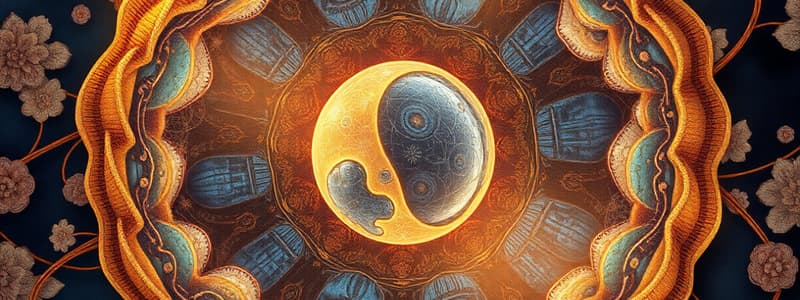Podcast
Questions and Answers
What is a main characteristic of prokaryotic cells?
What is a main characteristic of prokaryotic cells?
- Presence of membrane-bound organelles
- Compartmentalization of functions
- Lack of a nucleus (correct)
- Larger and more complex than eukaryotic cells
Which process is crucial for converting light energy into chemical energy in plants?
Which process is crucial for converting light energy into chemical energy in plants?
- Photosynthesis (correct)
- Mitosis
- Transcription
- Cellular respiration
What role do cell signaling pathways play in cells?
What role do cell signaling pathways play in cells?
- Increase cell size
- Promote cell division
- Maintain genetic information
- Facilitate communication and response to stimuli (correct)
Which of the following statements about Mendelian genetics is true?
Which of the following statements about Mendelian genetics is true?
What is a primary focus of ecology?
What is a primary focus of ecology?
Flashcards
Prokaryotic Cell
Prokaryotic Cell
A cell lacking a nucleus and other membrane-bound organelles.
Eukaryotic Cell
Eukaryotic Cell
A cell with a nucleus and membrane-bound organelles.
Gene
Gene
A unit of heredity, carrying instructions for protein synthesis.
Cellular Respiration
Cellular Respiration
Signup and view all the flashcards
Ecosystem
Ecosystem
Signup and view all the flashcards
Study Notes
Cell Biology
- Cells are the fundamental units of life, exhibiting a wide range of structures and functions.
- Prokaryotic cells, lacking a nucleus and other membrane-bound organelles, are generally smaller and simpler than eukaryotic cells.
- Eukaryotic cells, possessing a nucleus and organelles, are more complex and exhibit compartmentalization of functions.
- Cell membranes are selectively permeable, regulating the passage of substances into and out of the cell.
- Active transport mechanisms, such as pumps, are essential for moving molecules against their concentration gradients.
- Cellular respiration is the process by which cells obtain energy from organic molecules such as glucose.
- Photosynthesis, a process unique to plants, algae, and some bacteria, converts light energy into chemical energy.
- Cell division, including mitosis for growth and repair, and meiosis for sexual reproduction, is essential for maintaining and perpetuating life.
- Cell signaling pathways enable cells to communicate with each other and respond to external stimuli.
Genetics
- Genes, composed of DNA, are the units of heredity, carrying instructions for protein synthesis.
- DNA replication ensures that genetic information is accurately copied during cell division.
- Transcription converts the genetic information in DNA into RNA.
- Translation uses the information in RNA to synthesize proteins.
- Mutations are changes in the DNA sequence that can lead to various outcomes, from no effect to severe disease.
- Mendelian genetics describes patterns of inheritance for traits controlled by single genes.
- Modern genetics utilizes molecular techniques to study genes and their functions.
- Chromosomes are organized structures of DNA and proteins that carry genes.
- Genetic variations lead to diversity among individuals.
Ecology
- Ecology examines the interactions between organisms and their environment.
- Ecosystems comprise living organisms and their physical environment.
- Biodiversity refers to the variety of life in an ecosystem, from genes to species to ecosystems.
- Food webs depict the interconnected feeding relationships within an ecosystem.
- Energy flows through ecosystems, with producers converting solar energy into chemical energy.
- Population dynamics examines how populations change over time.
- Communities are groups of different species interacting in a particular area.
- Biomes are large-scale ecological communities characterized by specific climates and vegetation.
- Conservation biology aims to protect and preserve biodiversity.
Evolution
- Evolution is the change in heritable characteristics of biological populations over successive generations.
- Natural selection is a key mechanism of evolution, favoring traits that enhance survival and reproduction.
- Adaptation is the process by which organisms become better suited to their environment.
- Common ancestry explains the shared characteristics of different species.
- Vestigial structures are remnants of features that served a function in ancestral species.
- Speciation is the formation of new species.
- Genetic drift can alter allele frequencies in populations, especially in small groups.
- Fossils provide evidence for past life forms and evolutionary changes.
- Phylogeny reconstructs the evolutionary relationships between species.
Physiology
- Physiology studies the functions of an organism's structures.
- Homeostasis maintains stable internal conditions, despite external changes.
- Nervous and endocrine systems coordinate bodily functions.
- The immune system protects the body from pathogens.
- Respiration supplies organisms with oxygen and removes carbon dioxide.
- Circulation transports nutrients, oxygen, and waste products throughout the body.
- Excretion eliminates waste products.
- Digestion breaks down food into absorbable nutrients.
- Reproduction, in various forms, ensures continuation of species.
Microbiology
- Microbiology studies microscopic organisms, including bacteria, viruses, fungi, and protists.
- Microorganisms play vital roles in ecosystems, including decomposition and nutrient cycling.
- Pathogenic microorganisms can cause disease in other organisms.
- Antimicrobial agents are used to combat infections.
- Microbial genetics explores the properties and functions of microbial genomes.
- Microbial diversity encompasses a vast array of species and forms.
- Microbes can be used in biotechnology, industry, and agriculture.
- Virology describes viruses, their structure, and their interactions with host cells.
- Immunology examines the body's immune response to infectious agents.
Studying That Suits You
Use AI to generate personalized quizzes and flashcards to suit your learning preferences.




